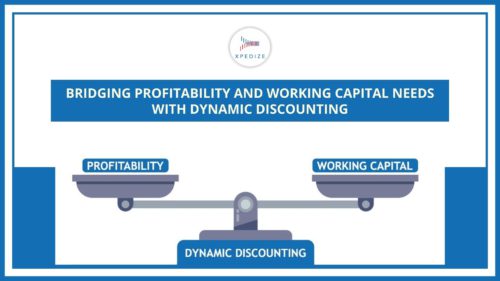
Introduction
The Buyer-Supplier Relationship is perhaps one of the most peculiar relationships in the Supply Chain. Empowered by economic inter-dependence, this relationship is further strengthened by their common objective: to build successful, sustaining Supply Chains. For Suppliers, the rationale to develop a dependable supply chain is to ensure their short-term working capital requirements are always met, while for the Buyer it helps ensure steady and timely delivery of goods.
In India, however, this coveted relationship tends to get strained due to a number of factors, most of which revolve around Payment Practices, changes in Working Capital requirements, Pandemics, Supply Chain inefficiencies, and more. Often, this leads to a marked increase in the Credit Risk Environment, which can result in a full-blown economic slowdown.
In today’s increasingly erratic and unpredictable economy, this leads to adverse results for the entire Supply Chain. Indian MSMEs, which account for the bulk of the Indian Suppliers, are adversely affected when their Working Capital Requirements are not met by the Supply Chain and/or the existing Financial System, especially during times of economic uncertainty. This can become a serious problem in developing countries like India, where lack of ready access to capital can spell serious trouble for millions of MSMEs.
The Context
As per a recent study by Atradius, Credit Risk and Business Performances have deteriorated in the country, with pertinent focus on the significant deterioration in the B2B-Payments Behaviour. While this has been attributed to the subsequent ‘waves’ of the COVID-19 Pandemic in the country by experts, the report goes on to state that there has been an approximate 3X increase in the number of write-offs of debt that is deemed ‘uncollectable’, and 2X increase in the average valuation of overdue bills/invoices.
This is a clear indication of the reduced risk appetite and an apparent increase in insolvencies, translating to a further increase in delayed payments within the Supply Chain and beyond. This particular statistic is of great significance for India, as we already face an average delay of Sixty-Five days to get payments after the date of their invoicing. As you might imagine, this would further deteriorate the financial plans of the MSMEs, leading to even more insolvencies.
The Solution
With problems of such magnitude rampant, one would expect the availability of a plethora of solutions (financial products in this case) designed specially to cater to the financial crunch.
This, however, is not entirely true. Till very recently, there existed only a few financial products. These included Working Capital Loans, CC Limits, Overdraft Facilities apart from loans and advances, and relied primarily on the creditworthiness of the aforementioned suppliers, requiring elaborate paperwork and involving excruciating amounts of time to process, rendering these virtually unhelpful.
This is what led to the introduction of simpler, more intuitive and accessible financial products that offered much better Supplier Financing Solutions. One of these solutions is Dynamic Discounting, which we believe, is perhaps the most effective.
Dynamic Discounting: A Brief Introduction.
Simply put, Dynamic Discounting refers to the process of offering discounts to the Buyers for early payment on approved bills/invoices for the products and/or services delivered by the Supplier. It has often been defined as a self-adjusting (hence ‘dynamic’ discounting) between the aforementioned parties where the discount offered by the supplier is dependent on how early the amount is paid, extending flexibility to the buyer to choose the when and how much for the payment. The earlier the payment is to be made, the higher would be the discount.
Keeping in mind the success of Dynamic Discounting Solutions in the market, this form of supplier financing has seen a steady increase in adoption across industries, especially those that are increasingly leveraging technology to improve efficiencies and reduce costs. More and more companies, led by their Accounts Payable, Procurement and Treasury Departments, as it serves a strategic investment opportunity for the company.
Dynamic Discounting initiatives, however, require comprehensive, technology-enabled software platforms that offer E-Invoicing services, Supplier Portals, Seamless Data Transfers, Uncompromised Date Security and an intuitive overall experience.
FinTechs such as Xpedize enable the process of dynamic discounting by integrating with buyers’ Enterprise Resource Planning Softwares (ERPs) to enable seamless data transfers, allowing smooth transactions.
Dynamic Discounting and the Great Indian Supply Chain.
Dynamic Discounting creates values for all members in the Supply Chain: For Buyers, who are more often than not the initiators, Dynamic Discounting essentially automates the complete discounting process for the organization while achieving higher returns than they otherwise would have with their Treasury Funds.
For the Suppliers, Dynamic Discounting is that miraculously affordable financing option that gets them easy access to cash, helping them optimize their Working Capital, and aiding in their liquidity. It ends up being a revolutionary program that prevents many an organization from going out of business, especially in the Indian context, where Suppliers, primarily MSMEs, are at a greater risk of getting delayed payments and thus face a greater magnitude of financial stress.
What does the future look like?
As Indian businesses are predicted to face a greater number of financial difficulties, Dynamic Discounting is one technique of Supplier Financing that shows the most potential. As the awareness about Invoice Discounting grows amongst the consumers, there seems to be a growing demand for platforms that offer these services, enabling all parties in the situation to thrive and survive in a definitively strained environment.
What improves these platforms’ adoption, awareness, and usage amongst the consumers is how streamlined their interface is, whether or not they have the capability to integrate with consumers’ ERPs, how secure they keep the data they are given access to, how they manage the relationship between the two parties to further strengthen the Supply Chain, and most importantly the consistency in delivering profitability, efficiency and compliance.
Xpedize, a pioneer in the domain of Supplier Financing Solutions in India, offers a comprehensive suite that leverages Dynamic Discounting to deliver an assured increase in organizational profitability (EBITDA) from the get-go.
Akshay Nagpal,
Xpedize Editorial Team.